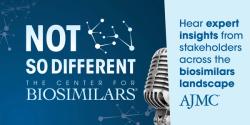© 2025 MJH Life Sciences™ and The Center for Biosimilars - Biosimilars, Health Economics & Insights. All rights reserved.
Unifying Standards: The Need for Streamlined Biosimilar Development
At the 2024 GRx+Biosims conference, industry leaders and regulatory experts underscored the urgency of unifying global standards and simplifying the biosimilar development process, sharing insights on recent advancements and the necessity for greater collaboration between manufacturers and regulatory agencies.
Regulatory experts and representatives from some of the top biosimilar manufacturers emphasized the importance of global harmonization and streamlining biosimilar development during a panel discussion at the 2024 GRx+Biosims conference.1
The event was held from October 21 to October 23, 2024, in Rockville, Maryland.
Cory Wohlbach, global vice president, biosimilars regulatory affairs at Teva Pharmaceuticals, provided an overview of biosimilar streamlining, focusing on progress made over the past couple years. He highlighted key advancements, such as the removal of animal toxicology testing and improvements in interchangeability status.2
Wohlbach emphasized the importance of global harmonization, noting the role of international regulatory experts. He also discussed recent updates, including the FDA's plan for an updated interchangeable guidance and a draft guidance for labeling.3 Looking ahead, Wohlbach outlined potential streamlining steps, including reducing routine requirements for clinical efficacy studies and moving towards a global comparator.
Elena Wolf-Holz, MD, PhD, head of the clinical development department at Biocon Biologics, discussed the regulatory landscape and the criteria for waivers of comparative efficacy studies (CES). She referenced a publication that outlined when a CES may be necessary and highlighted the status quo in the regulatory landscape, noting that clinical trials are not mandated for some markets. Wolf-Holz explained ongoing work at the FDA and European Medicines Agency (EMA) aimed at streamlining the process and creating a clear path for industry investments. She presented EMA and FDA papers, concluding that comparative efficacy studies were not predictive for marketing authorization.
“We need to future proof the legislation and the guidelines. We think regulatory science has evolved, and it keeps doing so. Any study involving human subjects must take particular care to contribute new knowledge, not otherwise obtainable and well established. Regulatory science supports the development of biosimilars based on analytical data. So, we need a modern bioscience pathway,” said Wolf-Holz.
Martin Schiestl, PhD, head of regulatory affairs policy at Sandoz, presented a case study on immunogenicity in a hypothetical streamlined development. He emphasized the need to ensure consistent immunogenicity through comparative analytical data and discussed risk factors that can increase unwanted immunogenicity, explaining how these can be managed through analytical methods. Schiestl presented a case study comparing US standards, showcasing the robustness of immunogenicity confirmation through analytical and clinical pharmacokinetic (PK) data. He concluded that a single-dose PK study in healthy volunteers is a sensitive tool for confirming comparability of immunogenicity.
Stacey Ricci, Meng, ScD, director of the scientific review staff in the Office of Therapeutics and Biosimilars at the FDA, discussed the agency's efforts and future goals to support streamlining biosimilar development. She highlighted the need to boost confidence in comparative analytical data and stressed the importance of education and communication.
“Generics have a different language than we do, right? They're the same. A generic is exactly the same as the branded product. [Biosimilars] have a difference so I think we have to be sensitive to the terminology and really help explain why it's different and what that means. And nevertheless, biosimilars are safe and effective, just like their reference projects,” Ricci stated.
Ricci mentioned ongoing FDA research, including a landscape assessment of biosimilar submissions, and shared insights from the International Pharmaceutical Regulators Programme, which identified the limitations of comparative efficacy studies and underscored the need for a risk-based framework. She outlined future goals for the FDA biosimilar working group, including refining concepts and drafting a concept paper.
During a discussion on internal barriers to streamlining, moderator Sarah Brown, PharmD, Associate director, regulatory affairs strategy and science, biosimilars, Sandoz, asked about challenges within the FDA and how the industry could assist in overcoming them. Ricci acknowledged the difficulty in reaching consensus within the FDA and stressed the importance of engaging all relevant offices and stakeholders. Schiestl and Wolf-Holz added their perspectives, emphasizing the role of clinical reviewers and the need for collaboration and education.
Wohlbach reiterated the need for industry to supply data supporting waivers of clinical efficacy studies and stressed the importance of global harmonization. The panelists agreed on the importance of industry collaboration and publishing data to support streamlining efforts.
In response to audience questions, the panelists discussed the adequacy of data packages for CES waivers and the role of pharmacodynamic markers. Ricci and Schiestl emphasized the importance of meeting with the FDA and submitting strong data packages to justify CES waivers. The panel concluded with a discussion on the potential for product-specific guidance and the ongoing efforts to streamline biosimilar development.
References
1. Brown S, Ricci S, Schiestl M, Wohlbach C, Wolf-Holz E. Streamlining biosimilar development. Presented at: GRx+Biosims; October 21-23, 2024; Rockville, Maryland.
2. Niazi S. BioRationality: FDA advice to biosimilar developers on using PD markers, avoid clinical efficacy testing. The Center for Biosimilars®. May 1, 2023. Accessed October 21, 2024. https://www.centerforbiosimilars.com/view/biorationality-fda-advice-to-biosimilar-developers-on-using-pd-markers-avoid-clinical-efficacy-testing
3. Jeremias S. FDA draft guidance removes switching study requirements for biosimilar interchangeability. The Center for Biosimilars. June 20, 2024. Accessed October 21, 2024. https://www.centerforbiosimilars.com/view/fda-draft-guidance-removes-switching-study-requirements-for-biosimilar-interchangeability



